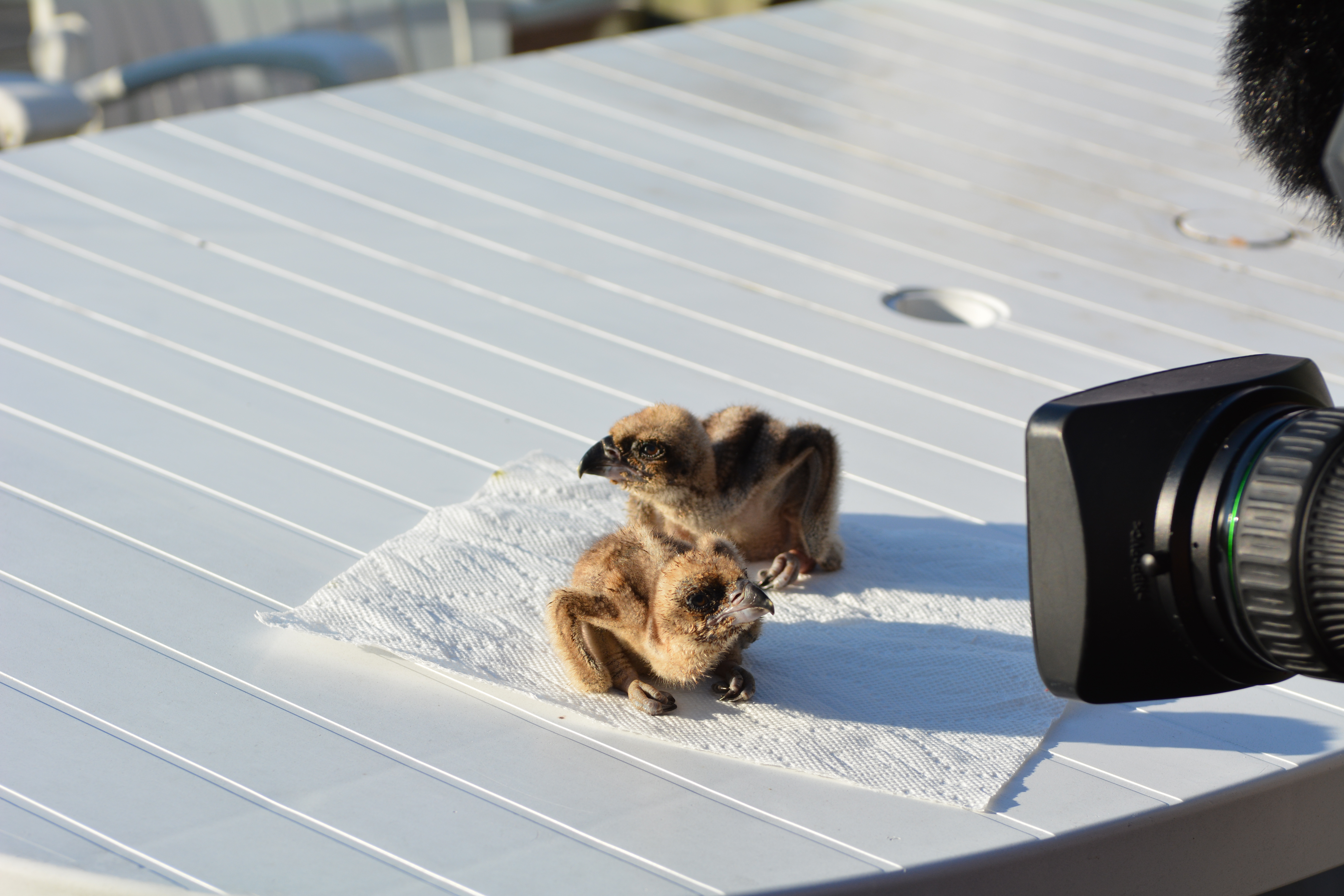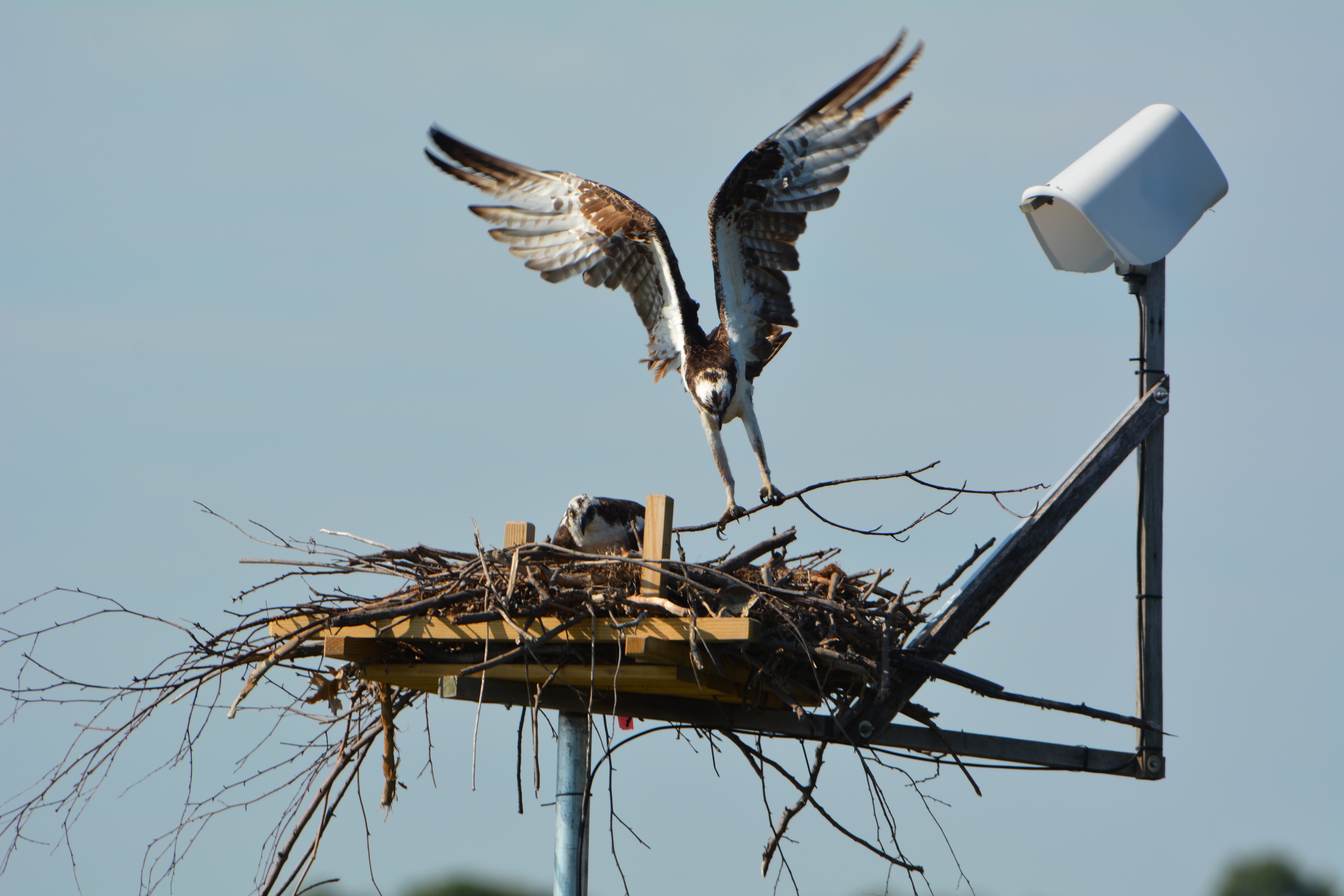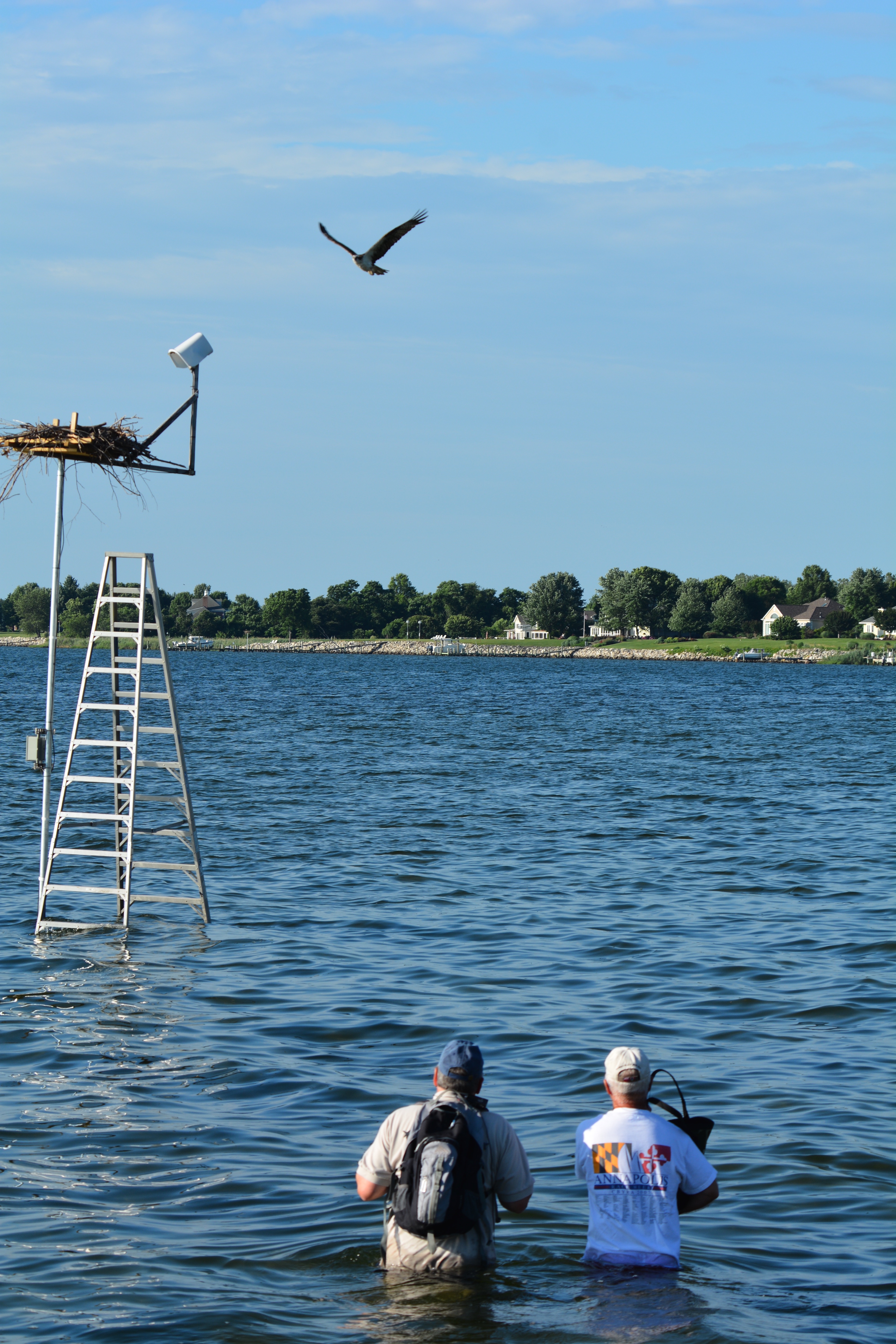Osprey Pair Featured on Chesapeake Conservancy Webcam Foster Two Chicks
Annapolis, MD – The Chesapeake Conservancy today announced that Tom & Audrey, a nesting pair of osprey who make their Maryland home along the shores of Kent Island, have accepted two foster chicks in their nest.
Tom was a new mate for Audrey this year, and they had three eggs that were not viable. This is not uncommon for first year mates. Dr. Paul Spitzer, an ornithologist with more than thirty years of experience working with ospreys, was consulted about the nonviable eggs. He was the first to suggest the possibility of Tom and Audrey becoming foster parents, a practice he has had great success with in the past.
The Chesapeake Conservancy contacted Craig Koppie, raptor biologist with the U.S. Fish and Wildlife Service (USFWS) Chesapeake Bay Field Office, about the potential of Tom and Audrey fostering chicks should there be a need to relocate chicks from an ill-fated nest in the Chesapeake Bay region.
Mr. Koppie observed Tom & Audrey’s behavior via the webcam and visited their nest site. As Tom and Audrey continued to incubate the nonviable eggs, Mr. Koppie made the determination that they presented an excellent fostering situation. However, an opportunity needed to present itself and that would be dependent on a variety of conditions. Chicks would have to be no older than two weeks but preferably in the 10-14 day period.
In May, the USFWS removed two eggs located on a piling where barges tie up at Poplar Island, an area deemed unsafe with a lot of disturbance, and placed them in a neighboring nest also on Poplar Island which was already home to three eggs. The Service’s intention was to relocate two or three chicks from this nest if all the eggs hatched. All five eggs were incubated by the female osprey in this nest and she successfully hatched four. One egg was either removed by a predator, or more likely disposed of by the osprey during incubation. Mr. Koppie determined that a foster parents nest would be necessary, as four young chicks are a heavy load to raise successfully.
USFWS biologists Peter McGowan and Robbie Callahan conduct annual bird population surveys on Poplar Island where there is a robust osprey population. On June 16, 2015, Mr. Koppie, Mr. McGowan and Mr. Callahan went to the donor nest location and saw that all four chicks were doing well. An assessment was made to take the two chicks with the greater weight and body condition.
During the morning of June 17, 2015, the two foster chicks were placed in Tom and Audrey’s nest. With great anticipation, the parents flew back to the nest to find they indeed “hatched” young after all. Tom and Audrey readily accepted the foster chicks as their own.
 “We currently have about 8,000 visitors a day from around the world viewing the Chesapeake Conservancy’s osprey and falcon webcams. It’s been a real cliffhanger this season for those watching Tom and Audrey, filled with ups and downs. There’s a new ‘Tom’ this year. There was joy and then sadness with nonviable eggs. Now, there’s an opportunity for Tom and Audrey to help by fostering two chicks that were removed from an ill-fated nest,” Joel Dunn, president and CEO of the Chesapeake Conservancy, said.
“We currently have about 8,000 visitors a day from around the world viewing the Chesapeake Conservancy’s osprey and falcon webcams. It’s been a real cliffhanger this season for those watching Tom and Audrey, filled with ups and downs. There’s a new ‘Tom’ this year. There was joy and then sadness with nonviable eggs. Now, there’s an opportunity for Tom and Audrey to help by fostering two chicks that were removed from an ill-fated nest,” Joel Dunn, president and CEO of the Chesapeake Conservancy, said.
“This pair was incredibly determined to hatch and rear young. I am glad to see that a solution was possible, and it was done in a collaborative manner that was a win for wildlife and our osprey-cam viewing public,” Craig Koppie, raptor biologist with the U.S. Fish and Wildlife Service Chesapeake Bay Field Office, said.
“This is the first time in twenty years that we did not have at least one egg hatch in our nest. It has been very hard for us to  look out our window every day and see Tom and Audrey so diligently sitting on their eggs through wind, rain and blistering heat when we knew the eggs were no longer viable,” Crazy Osprey Family (a moniker used for the homeowners who host Tom and Audrey’s nest, so that they may remain anonymous), said.
look out our window every day and see Tom and Audrey so diligently sitting on their eggs through wind, rain and blistering heat when we knew the eggs were no longer viable,” Crazy Osprey Family (a moniker used for the homeowners who host Tom and Audrey’s nest, so that they may remain anonymous), said.
“We were so encouraged by Dr. Spitzer’s suggestion to find a foster chick for our faithful osprey pair. The fact that he has been so successful in transferring eggs and chicks during his DDT studies was a great comfort to us. We are also so fortunate to have Craig Koppie’s expertise, enthusiasm and positive attitude, which allowed Tom and Audrey the chance to raise a family this season. Finally, many thanks to the dedicated folks at the Chesapeake Conservancy for putting all the pieces together to make this happen,” Crazy Osprey Family, continued.
The public may view Tom & Audrey and the two foster chicks on the Chesapeake Conservancy’s osprey webcam at www.chesapeakeconservancy.org/osprey-cam, and read the entertaining “Osprey Camera Blog” written by the Crazy Osprey Family.
The U.S. Fish and Wildlife Service also maintains an osprey webcam at Masonville Cove available at www.fws.gov/chesapeakebay/OspreyCam/index.html.
After removing them from the donor nest, the osprey chicks were fed and cared for by Mr. Koppie. He needed fresh fish to maintain their body fluids and nutritional requirement until the transfer the following day. Generously, Mr. Tom Collins of Kool Ice & Seafood Co., Inc. in Cambridge, Maryland, kindly donated a bag of fresh menhaden for the osprey. He too, has an attachment for them since he watches a nest near his home.
 The Chesapeake Conservancy extends our special thanks to Craig Koppie, Peter McGowan, Robbie Callahan and the U.S. Fish and Wildlife Service Chesapeake Bay Field Office, Investigative Options Inc., for installing, setting up and maintaining the camera; Skyline Technology Solutions, for managing the video stream, and “The Crazy Osprey” family who generously host the platform and equipment and write the blog.
The Chesapeake Conservancy extends our special thanks to Craig Koppie, Peter McGowan, Robbie Callahan and the U.S. Fish and Wildlife Service Chesapeake Bay Field Office, Investigative Options Inc., for installing, setting up and maintaining the camera; Skyline Technology Solutions, for managing the video stream, and “The Crazy Osprey” family who generously host the platform and equipment and write the blog.
Found on every continent except Antarctica, osprey (Pandion haliaetus) are one of the Chesapeake’s most amazing birds for a number of reasons. They migrate thousands of miles each year to and from Central and South America, mate for life, and return to the same spot year after year, despite spending the winter apart from each other.
After an almost 90% decline in population from 1950-1970, osprey populations have rebounded due in large part to conservation efforts and the banning of DDT. Osprey can be a valuable indicator species for monitoring the long-term health of the Chesapeake Bay because their diet consists almost entirely of fish and they are sensitive to many environmental contaminants. To make sure these magnificent Bay residents continue to thrive, we are working to ensure that river corridors remain protected and that the Chesapeake Bay can support abundant fish populations.
To learn more about osprey and the Bay’s other amazing creatures use our National Wildlife Refuge App, or visit the Captain John Smith Chesapeake National Historic Trail managed by the National Park Service where you can see many osprey.
Learn more about osprey with our frequently asked questions and fun facts here.
###
The Chesapeake Conservancy’s mission is to strengthen the connection between people and the watershed, conserve the landscapes and special places that sustain the Chesapeake’s unique natural and cultural resources, and encourage the exploration and celebration of the Chesapeake as a national treasure. For more information, please visit www.ChesapeakeConservancy.org